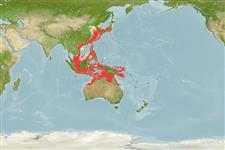sub class Elasmobranchii (ฉลามและกระเบน) (sharks and rays) >
Heterodontiformes (Bullhead and horn sharks) >
Heterodontidae (Bullhead, horn, or Port Jackson sharks)
Etymology: Heterodontus: heteros (Gr.), different; odontos (Gr.), tooth, referring to pointy teeth (for clutching prey) at front of jaws, different than rounded molar-like teeth (for grinding hard-shelled invertebrates) at the back. (See ETYFish); zebra: Referring to 12 narrow brown or black zebra-like stripes on body. (See ETYFish).
More on author: Gray.
Environment: milieu / climate zone / depth range / distribution range
นิเวศวิทยา
เกี่ยวกับทะเล,น้ำเค็ม เกี่ยวกับหินโสโครก; ระดับความลึก 0 - 200 m (Ref. 6871). Subtropical; 40°N - 20°S, 103°E - 155°E
Western Pacific: Japan to northwestern Australia (Ref. 6871) and Queensland.
Length at first maturity / ขนาด / น้ำหนัก / Age
Maturity: Lm ?, range 84 - ? cm
Max length : 125 cm TL เพศผู้/กระเทย; (Ref. 2334)
เงี่ยงครีบหลัง (รวม): 2; ก้านครีบอ่อนที่หาง (รวม): 0; เงี่ยงครีบก้น 0; ก้านครีบอ่อนที่ก้น: 0. The Zebra bullhead shark, Heterodontus zebra, has a large blunt head, low supra-orbital crest gradually sloping behind eyes, dorsal fin spines, anal fin, and zebra-pattern of dark, narrow vertical bands on a pale background (Ref. 9838; 6871). As characteristic of members of the family, caudal fin with a moderately long dorsal lobe and moderately long ventral lobe, the latter shorter than the dorsal lobe, vertebral axis raised into caudal-fin lobe (Ref.9838).
A common but little-known shark found on the continental and insular shelves in depths down to at least 50 m (Ref. 247, 11230) in the South China Sea, but deeper and in 150 - 200 meters off Western Australia (Ref. 43278). Probably feeds on bottom invertebrates and small fishes (Ref. 6871). Oviparous (Ref. 247).
Life cycle and mating behavior
วัยเจริญพันธุ์ | การสืบพันธุ์ | การวางไข่ | เซลสืบพันธ์ของเพศเมีย(ไข่) | ความดกของไข่ | ตัวอ่อน
Oviparous, paired eggs are laid. Embryos feed solely on yolk (Ref. 50449). Distinct pairing with embrace (Ref. 205). Lays auger type eggs (about 12-18cm, 4.7-7 inches long) among rocks & kelp, often with more than female using same oviposition site, with as many eggs found in a single nest; female lay 2 eggs at a time, from spring to late summer in Japan, 6-12 times during a single spawning season. Eggs hatch in 1 year. Hatch at 18 cm (7 inches), max length at 1.2m (3.9 ft.). During courtship, male grasps pectoral fin of female & wraps posterior part of body under her so single clasper can be inserted into her cloaca. In several mating bouts observed, copulation lasted as long as 15 minutes (Ref. 12951).
Compagno, L.J.V., 2001. Sharks of the world. An annotated and illustrated catalogue of shark species known to date. Vol. 2. Bullhead, mackerel and carpet sharks (Heterodontiformes, Lamniformes and Orectolobiformes). FAO Spec. Cat. Fish. Purp. 1(2):269 p. FAO, Rome. (Ref. 43278)
IUCN Red List Status (Ref. 130435)
Threat to humans
Traumatogenic
Human uses
การประมง: มีการค้าเพียงเล็กน้อย; สถานที่แสดงสัตว์และพืชน้ำ: เป็นไปได้
ข้อมูลเพิ่มเติม
อ้างอิงการเพาะเลี้ยงสัตว์น้ำประวัติการเพาะเลี้ยงสัตว์น้ำสายพันธุ์พันธุศาสตร์ElectrophoresesอัตราพันธุกรรมโรคการแปรรูปNutrientsMass conversion
เครื่องมือ
Special reports
Download XML
แหล่งที่มาจากอินเตอร์เน็ต
Estimates based on models
Preferred temperature (Ref.
123201): 15.4 - 26.6, mean 21.8 °C (based on 223 cells).
Phylogenetic diversity index (Ref.
82804): PD
50 = 0.5059 [Uniqueness, from 0.5 = low to 2.0 = high].
Bayesian length-weight: a=0.00380 (0.00166 - 0.00872), b=3.15 (2.95 - 3.35), in cm total length, based on LWR estimates for this (Sub)family-body shape (Ref.
93245).
ระดับชั้นอาหาร (Ref.
69278): 4.0 ±0.66 se; based on food items.
ความสามารถในการกลับคืนสู่ปกติ (Ref.
120179): ต่ำ, เวลาต่ำสุดที่จะทำให้ประชากรเพิ่มขึ้นเป็น 2 เท่าใช้เวลา 4.5 - 14 ปี (Fec assumed to be <100).
Fishing Vulnerability (Ref.
59153): High to very high vulnerability (75 of 100).
